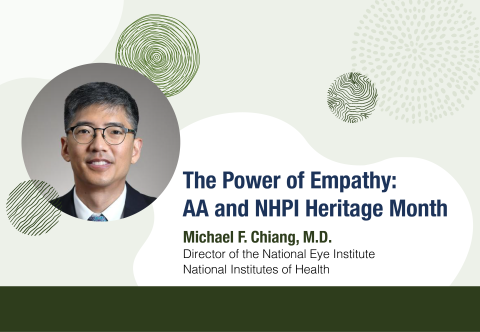
Photo of Michael F. Chiang, Director of the National Eye Institute: Credit: NEI
The power of empathy can’t be understated.
It helps broaden our outlook to embrace a diverse scientific workforce.
I was reminded of this when I spoke with National Eye Institute (NEI) Director Michael F. Chiang, M.D.
I reached out to Dr. Chiang in honor of Asian American, Native Hawaiian, and Pacific Islander (AA and NHPI) Heritage Month. This month provides an opportune time to learn more about the heritage, hopes, and concerns of our AA and NHPI colleagues and friends.
As Dr. Chiang said, “It is my hope that by learning more about the challenges of others, we develop deeper empathy by seeing more of ourselves in people from different backgrounds.”
AA and NHPI Representation at NIH
“AA and NHPI people make up 20% of the workforce at NIH and about 60% of the population worldwide,” said Dr. Chiang. “This has implications not only for all of us who work here, but for people nationally and around the world. I think it is crucial to ensure that the voices and perspectives of the AA and NHPI group are represented while making decisions.”
Since 2020, Dr. Chiang has been one of those voices at NIH. He is the first NEI Director from within the AA and NHPI community.
“In general, I believe organizations are strongest when they have leaders that reflect a diversity of backgrounds and experiences,” said Dr. Chiang.
The Myth of the “Model Minority”
“In 2023, there is much more recognition of the cultural, language, and other challenges faced by AA and NHPI and other recent immigrants to this country,” said Dr. Chiang, “and there is more recognition that AA and NHPIs are an extremely heterogeneous group with significant diversity within this group with regard to background and opportunities.”
As some of the fastest-growing racial and ethnic groups in the United States, AA and NHPI communities represent a multitude of ethnicities, languages, and experiences. In other words, he said, “The stereotype of AA and NHPIs as a ‘model minority’ truly is a myth.”
Leaders Who Look Like You
“Historically, diversity initiatives and programs have not always been directed toward AA and NHPI groups,” said Dr. Chiang.
This was certainly the case when Dr. Chiang was growing up.
Despite being born in the United States, Dr. Chiang’s first language was Mandarin Chinese. He learned English from watching Sesame Street, which helped, but he said, “On the first day of kindergarten, I remember feeling disoriented because I was not comfortable speaking English.”
Growing up in Michigan, Dr. Chiang said that there weren’t many children who looked like him. Even years later, when he trained in ophthalmology in the late 1990s and early 2000s, he said, “There were barely any ophthalmology faculty who were of Asian descent.”
These experiences gave him an appreciation for the significance of having role models and supervisors who “look like you.”
A Fantastic Role Model
While there have been relatively few AA and NHPI leaders in biomedical and behavioral science, Dr. Chiang feels fortunate that his first department chair was one of the earliest Asian American ophthalmology leaders in the country. Stanley Chang, M.D., pioneered surgical techniques and devices to treat specific eye disorders that are used all over the world.
“Clinically, he was a fantastic role model,” said Dr. Chiang. “At the beginning of my career, he gave me leadership opportunities and often told me, ‘You’ll become chair of a major department someday,’ although leadership was not something I envisioned at that time. Stanley helped me realize that I love building teams and that I could successfully lead groups.”
Keep the Conversation Going
If you’re a member of the AA and NHPI community, this month provides an opening to consider sharing aspects of your story with your colleagues. As for those who aren’t part of this group, this is a good chance to listen and learn from our AA and NHPI colleagues.
Remember, empathy helps us learn more about each other—and ourselves.
Advice for Early Career Scientists from Dr. Chiang
- Select good mentors who can help with your educational and career development. Outstanding mentors helped me become a better scientist and navigate the personal and political aspects of the field.
- Find collaborators from different disciplines. I’m amazed by how many insights we get from people who were trained in other fields and who approach the same problems using different methodologies or from differing perspectives.
- Try to make sure you have fun while working—not only by selecting topics and questions that you’re curious about, but also by finding people whom you enjoy being around. At the beginning of my career, I never could have imagined how many of my closest friendships would come through work—or how many great memories would come from solving problems together.

